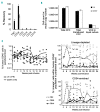Novel lineage depletion preserves autologous blood stem cells for gene therapy of Fanconi anemia complementation group A
- PMID: 29976742
- PMCID: PMC6278989
- DOI: 10.3324/haematol.2018.194571
Novel lineage depletion preserves autologous blood stem cells for gene therapy of Fanconi anemia complementation group A
Abstract
A hallmark of Fanconi anemia is accelerated decline in hematopoietic stem and progenitor cells (CD34 +) leading to bone marrow failure. Long-term treatment requires hematopoietic cell transplantation from an unaffected donor but is associated with potentially severe side-effects. Gene therapy to correct the genetic defect in the patient's own CD34+ cells has been limited by low CD34+ cell numbers and viability. Here we demonstrate an altered ratio of CD34Hi to CD34Lo cells in Fanconi patients relative to healthy donors, with exclusive in vitro repopulating ability in only CD34Hi cells, underscoring a need for novel strategies to preserve limited CD34+ cells. To address this need, we developed a clinical protocol to deplete lineage+(CD3+, CD14+, CD16+ and CD19+) cells from blood and marrow products. This process depletes >90% of lineage+cells while retaining ≥60% of the initial CD34+cell fraction, reduces total nucleated cells by 1-2 logs, and maintains transduction efficiency and cell viability following gene transfer. Importantly, transduced lineage- cell products engrafted equivalently to that of purified CD34+ cells from the same donor when xenotransplanted at matched CD34+ cell doses. This novel selection strategy has been approved by the regulatory agencies in a gene therapy study for Fanconi anemia patients (NCI Clinical Trial Reporting Program Registry ID NCI-2011-00202; clinicaltrials.gov identifier: 01331018).
Copyright© 2018 Ferrata Storti Foundation.
Figures





Similar articles
-
Engraftment and in vivo proliferation advantage of gene-corrected mobilized CD34+ cells from Fanconi anemia patients.Blood. 2017 Sep 28;130(13):1535-1542. doi: 10.1182/blood-2017-03-774174. Epub 2017 Aug 11. Blood. 2017. PMID: 28801449
-
Minimal conditioning in Fanconi anemia promotes multi-lineage marrow engraftment at 10-fold lower cell doses.J Gene Med. 2018 Oct;20(10-11):e3050. doi: 10.1002/jgm.3050. Epub 2018 Oct 1. J Gene Med. 2018. PMID: 30129972
-
Therapeutic gene editing in CD34+ hematopoietic progenitors from Fanconi anemia patients.EMBO Mol Med. 2017 Nov;9(11):1574-1588. doi: 10.15252/emmm.201707540. EMBO Mol Med. 2017. PMID: 28899930 Free PMC article.
-
Advances in Gene Therapy for Fanconi Anemia.Hum Gene Ther. 2018 Oct;29(10):1114-1123. doi: 10.1089/hum.2018.124. Hum Gene Ther. 2018. PMID: 30117331 Review.
-
Finding the needle in the hay stack: hematopoietic stem cells in Fanconi anemia.Mutat Res. 2009 Jul 31;668(1-2):141-9. doi: 10.1016/j.mrfmmm.2009.03.010. Epub 2009 Apr 2. Mutat Res. 2009. PMID: 19508850 Free PMC article. Review.
Cited by
-
Viral-based gene therapy clinical trials for immune deficiencies and blood disorders from 2013 until 2023 - an overview.Regen Ther. 2024 Dec 31;28:262-279. doi: 10.1016/j.reth.2024.12.007. eCollection 2025 Mar. Regen Ther. 2024. PMID: 39844821 Free PMC article. Review.
-
Enrichment strategies to enhance genome editing.J Biomed Sci. 2023 Jul 1;30(1):51. doi: 10.1186/s12929-023-00943-1. J Biomed Sci. 2023. PMID: 37393268 Free PMC article. Review.
-
Inducible Sbds deletion impairs bone marrow niche capacity to engraft donor bone marrow after transplantation.Blood Adv. 2022 Jan 11;6(1):108-120. doi: 10.1182/bloodadvances.2021004640. Blood Adv. 2022. PMID: 34625796 Free PMC article.
-
Effective Multi-lineage Engraftment in a Mouse Model of Fanconi Anemia Using Non-genotoxic Antibody-Based Conditioning.Mol Ther Methods Clin Dev. 2020 Feb 8;17:455-464. doi: 10.1016/j.omtm.2020.02.001. eCollection 2020 Jun 12. Mol Ther Methods Clin Dev. 2020. PMID: 32226796 Free PMC article.
-
Purification of Human CD34+CD90+ HSCs Reduces Target Cell Population and Improves Lentiviral Transduction for Gene Therapy.Mol Ther Methods Clin Dev. 2020 Jul 15;18:679-691. doi: 10.1016/j.omtm.2020.07.010. eCollection 2020 Sep 11. Mol Ther Methods Clin Dev. 2020. PMID: 32802914 Free PMC article.
References
-
- Nalepa G, Clapp DW. Fanconi anaemia and cancer: an intricate relationship. Nat Rev Cancer. 2018;18(3):168–185. - PubMed
-
- Adair JE, Sevilla J, Heredia CD, Becker PS, Kiem HP, Bueren J. Lessons learned from two decades of clinical trial experience in gene therapy for Fanconi anemia. Curr Gene Ther. 2017;16(5):338–348. - PubMed
Publication types
MeSH terms
Substances
Grants and funding
LinkOut - more resources
Full Text Sources
Other Literature Sources
Medical
Research Materials

